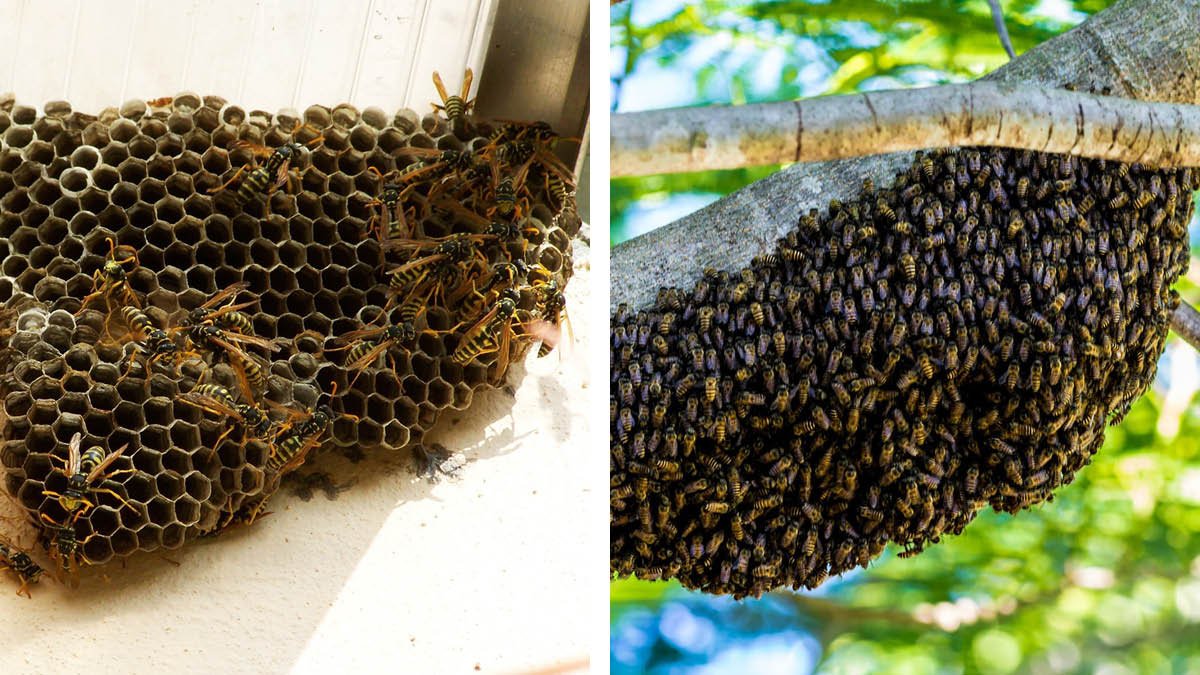Wasps: How to tell the difference between wasps and bees
/In Scotland it feels rare that we get a lovely day, so when we do we are always determined to make the most of it. However there always seems to be one thing that comes along and spoils it - those bloody wasps!
Wasps and bees are often confused, and i’m going to guess that you’ve mistakenly ran away from a bee more than once in your life!
So how do you actually tell the difference between a wasp and a bee?
In this article we’re going to show you their key characteristics so that you can stop panicking every time you see a yellow jacket insect flying around your picnic area.
Why are bees important to protect?
The Telegraph Newspaper recently reported that “Bees contribute £651 million to the UK economy a year, £150 million more than the Royal Family brings in through tourism.”
How is this you ask? Well ranked as the world number one pollinator of food crops, they are responsible for securing homegrown produce across the UK. Without them this would be drastically reduced.
Over the past half century there has been a huge decline in bees, with Honeybee colonies dropping from 250,000 in 1950’s to fewer than 100,000 today.
There have been many campaigns launched to support the bees, some of which can be simply done at home by planting more flowers in your gardens and actually letting your grass grow a little longer before cutting it back.
If you want to know what else you can do for the bees, why not check out the friends of the earth website for some tips
Bees and Wasps Identification: An Introduction
We’ve explained the benefits of bees but wasps aren’t actually all bad, they are in fact also great pollinators for our plants and crops. However they get their bad reputation due to their more aggressive behaviour.
If they aren’t doing you any harm we’d suggest leaving them be, however we also understand that having them on mass particularly around kids and pets is not an enjoyable experience.
Wasp stings although not pleasant can be as mild as a small swelling, with the pain subsiding after a few hours. However they can also be really dangerous, causing people to go into Anaphylaxis. For this reason we would advise that you always get a professional pest controller in to get rid of a wasps nest unless it is in the very early stages.
As for bees nests we would never recommend disposing of the hive as they are an endangered species that our country needs for its pollination services, unless they are causing a health and safety hazard. If this is the case we would advise getting in the local bee keepers as they will be able to move them to another location
The question still stands though, how do we tell the difference between a bee and wasp?
Bees and Wasps Identification: How to identify a wasp:
1) Look at its body.
Wasps will have a ‘waist’, where their body joins. They are also thinner and have longer bodies and legs than bees.
2) Check the colour
When we think of wasps and bees, we automatically think of black and yellow colouring. However, the bright yellow stripes are more obvious on a wasp, than a bee. So, if it looks bright yellow, it’s most likely to be wasp.
3) Look at its behaviour
Wasps tend to be more aggressive by nature. And although they won’t go out of their way to sting you, they do tend to hover around humans. Wasps will also be attracted to rubbish or human food, so if you feel like your picnic is under attack, it’s most likely to be a wasp that you’re facing!
4) Identify the nest
Wasps tend to have paper like nests, with distinctive grooves on them. They are made from chewed wood pulp that they gather during the early part of the year. A wasp nest is small in size at the start (golf ball sized); but can quite quickly grow to larger than a football. They are usually located somewhere sheltered near a source of wood; roof spaces, sheds and roof eaves are frequently used. To find a wasps nest just follow where they are coming from, they tend to move in fairly direct flight patterns once they’ve found a food source.
Different types of wasps
It’s said that in the UK we have 9 main kinds of wasps. However, the most common wasps we will see is the ‘yellow jacket’ or the ‘hornets.’ Hornets tend to be bigger than yellow jackets and can look quite frightening. Hornets are also more aggressive than regular wasps. Both wasps however are likely to sting if they feel threatened, so it’s important to stay calm around them and either guide them out the house or move away from them when possible.
Bees and Wasps Identification: How to Identify Bees
1) Look at the body
Bee’s tend to be rounder in shape than wasps, with thick middles. Bumblebees in particular are large and round.
However not all bees are completely round so make sure you look at their middles to see whether or not they have that distinctive ‘waist’ that wasps have when trying to identify them.
In addition the most noticeable feature of bees is that they are hairy, where wasps are not.
2) The colour
Although we’ve been drawing bee’s as little yellow and black blobs since we were tiny, bees aren’t actually yellow. Bee’s tend to be more orange/brown in colour and their individual stripes stand out less than those of a wasp.
3) Observe the behaviour
Bee’s tend to be passive insects, they get on with their own jobs, never really bothering humans unless they feel threatened. You will also almost always find bee’s around flowers and bushes, rather than around human food. So, when it’s bee’s around you know not to worry, your ice cream is safe!
4) Their Nest
You will usually find Bee nests in cavities such as tree hollows, roof spaces and even underground. Due to their honey making capabilities, their nests are made of hexagonal cells made of bee wax, called a honeycomb. You may even find a couple of dead bees at the entranceway, as the worker bees push out the dead or weak ones to make room in the hive.
Different types of Bee
In the UK we have 250 different kinds of bees, however there are a few key kinds that we see more than others. The main groups of bees’ you will see are the Bumblebee’s, the Honeybees, the Mason bees, and the Mining Bees. These different kinds of bee’s in general are all harmless unless threatened.
Bumblebees are social insects and with 24 species of bumble bees in the UK alone, it’s not surprising that we tend to see these around our parks and flower beds. They tend to be distinguished by their shape as they are round and fuzzy. Some may have white, red or orange tails but these are all just indicators of the kind of bumblebee they are.
Honey bees are a slim bee, sand coloured with golden amber bands. Today, however it is rarer to see wild honey bees as they tend to live in domestic hives, looked after by bee keepers.
Mason Bees are another kind of popular bee and you’ll tend to find them buzzing around brick walls. They stand out as they have long hair and boxy heads. Mason bee’s actually don’t have the capability to sting so in fact are totally harmless.
Mining Bees are a solitary species that nests in the ground, and they aren’t seen as often. However, you can find them in parks, gardens and near bare earth. They can range in size, but you can usually distinguish them by their colour. Mining bees tend to either have bright ginger bodies or be completely ashy.
Although all the bees have different roles, they all have the same passive nature. Bee’s won’t harm you, if you don’t harm them. If you want to be able to identify the different kinds of bees in more detail, why not check out this article by the Woodland Trust
Summary…
Bees play a massive part in pollinating our crops as well as making honey and beeswax. It is important that we don’t just jump the gun and swat them down as they are an endangered species and need protected.
Knowing the difference between bees and wasps will not only help us protect them, it will also likely reduce the immediate panic when one flies by at our next barbecue.
If you find yourself having a recurring wasp issue, it is likely you have a wasp nest; for advice on finding it read...
Got a Bee or wasps nest to get rid of ?
If it is bees, contact East of Scotland Bee Keepers Association
If it is wasps contact your local Pest Controller, click here for price information on our wasp nest removal services.









